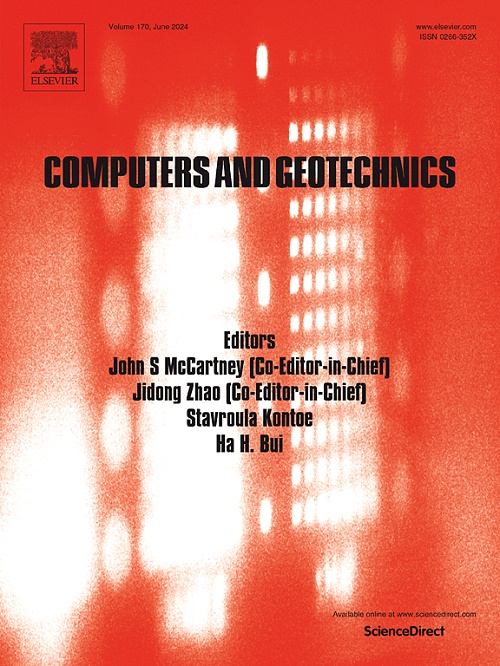DEM中凸多面体颗粒接触点精确计算的新算法
IF 5.3
1区 工程技术
Q1 COMPUTER SCIENCE, INTERDISCIPLINARY APPLICATIONS
引用次数: 0
摘要
接触检测和接触几何是离散元法(DEM)仿真中最重要的步骤。准确地表示两颗粒之间的接触是至关重要的,在用多面体颗粒模拟裂隙岩石时,接触点计算的准确性对于获得真实可靠的模拟结果至关重要。在DEM模拟中,接触点是对粒子施加接触力的地方,因此,该点的不准确表示会导致作用在粒子上的人工扭矩,从而导致非物理旋转和粒子相互作用。本文提出了一种精确计算多面体粒子碰撞接触点的新算法。该算法使用粒子的拓扑结构来确定它们与接触平面的相互作用,而不是直接相互作用。新算法通过减轻与接触点计算中的误差和零星运动相关的数值诱导不稳定性,在DEM模型的全局稳定性方面提供了改进的性能。通过几个例子展示了新算法的性能,这些例子说明了准确地表示接触点是生成可靠数值模拟的必要条件。本文章由计算机程序翻译,如有差异,请以英文原文为准。
A new algorithm for accurate contact point calculation between convex polyhedral particles in DEM
Contact detection and contact geometry are among the most important steps in Discrete Element Method (DEM) simulations. Accurately representing the contact between two particles is crucial, and when modeling fractured rock using polyhedral particles, the accuracy of the contact point calculation is essential for obtaining realistic and reliable simulation results. The point of contact is where contact forces are applied to particles in a DEM simulation and, thus, an inaccurate representation of that point leads to artificial torque acting on particles, resulting in non-physical rotation and particle interactions.
Herein we present a new algorithm for accurately calculating the contact point between two colliding polyhedral particles. The algorithm uses the topology of the particles to assert their interaction with the plane of contact and not directly with each other. The new algorithm provides improved performance in terms of global stability of DEM models by mitigating numerically induced instability associated with errors and sporadic movement in the contact point calculation. The performance of the new algorithm is showcased in several examples that illustrate how accurately representing the contact point is a requirement for generating reliable numerical simulations.
求助全文
通过发布文献求助,成功后即可免费获取论文全文。
去求助
来源期刊

Computers and Geotechnics
地学-地球科学综合
CiteScore
9.10
自引率
15.10%
发文量
438
审稿时长
45 days
期刊介绍:
The use of computers is firmly established in geotechnical engineering and continues to grow rapidly in both engineering practice and academe. The development of advanced numerical techniques and constitutive modeling, in conjunction with rapid developments in computer hardware, enables problems to be tackled that were unthinkable even a few years ago. Computers and Geotechnics provides an up-to-date reference for engineers and researchers engaged in computer aided analysis and research in geotechnical engineering. The journal is intended for an expeditious dissemination of advanced computer applications across a broad range of geotechnical topics. Contributions on advances in numerical algorithms, computer implementation of new constitutive models and probabilistic methods are especially encouraged.
 求助内容:
求助内容: 应助结果提醒方式:
应助结果提醒方式:


